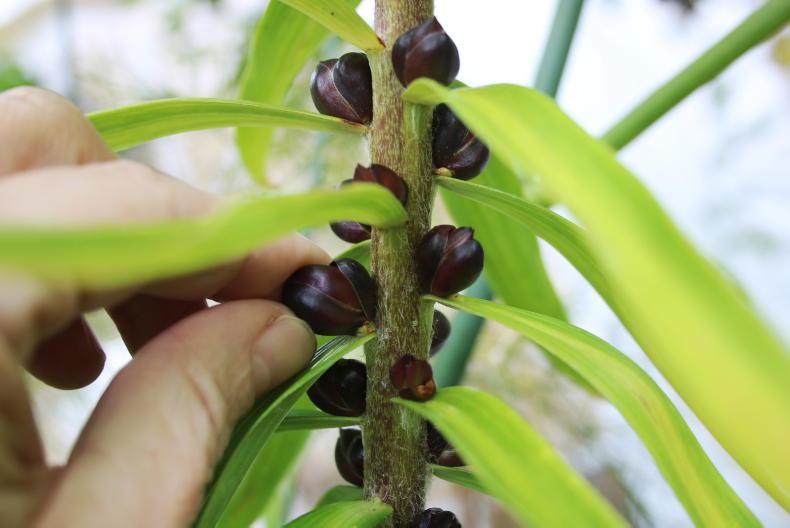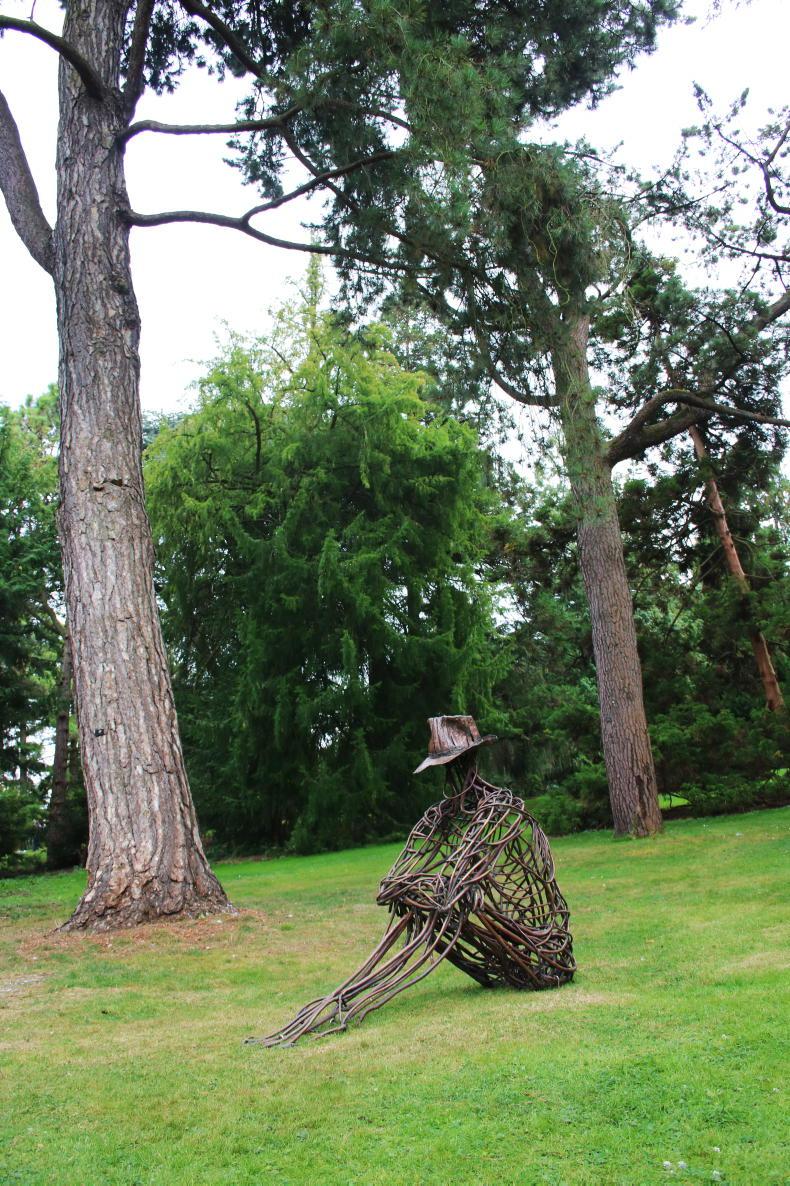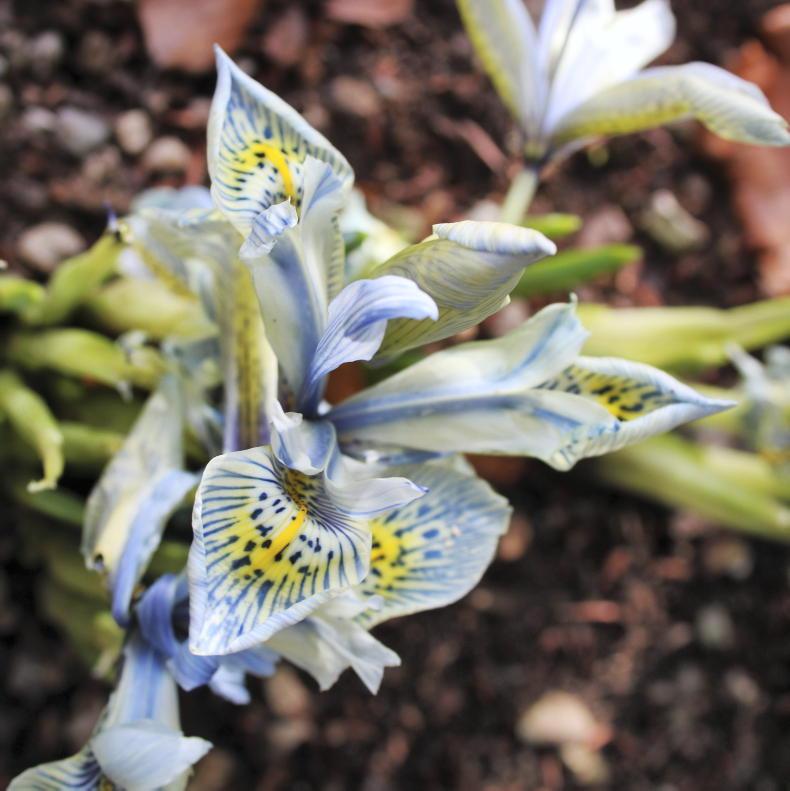The recent heatwave and the prolonged period of hot and dry weather of the last few months, coupled with the cumulative impact of similar conditions over the last five years or so, has really brought home to me that we need to adapt our garden for extended heatwaves and periods of little rainfall in the future.
Signs of water stress are everywhere throughout the garden. Many established and mature trees have been forced into survival mode and have prematurely been shedding their leaves to conserve water, sparking what is referred to as a “false” or early autumn.
The plants that have fared best are those that were heavily mulched with farmyard manure this past spring.
For me, drought-proofing a garden starts with the soil and mulch is key as it helps to keep moisture within the soil. Other suitable mulch materials include woodchip, leaf mould, compost and gravel.
Mulch should be applied in a thick layer, up to 10cm deep, when the soil is moist either in autumn or spring, to lock the moisture in. Dense planting with good groundcover plants, such as hardy geranium or bergenia, will also act as a mulch, covering bare soil and helping to prevent evaporation.
To make wise use of limited water supplies, we will have to become increasingly selective in what we choose to water, prioritising those plants that we want to save while accepting the abandonment of others to inevitable loss.
When watering, it is better to water deeply and less frequently, rather than little and often, so water soaks deep into the soil. This encourages plants to develop extensive root systems, which reach down for residual water when the going gets tough.
In preparation for next summer, we are looking towards installing an even more efficient means of watering. Drip irrigation systems or porous soaker hoses are excellent because they slowly apply moisture directly to the roots of the plant where it is most effective.
We will also have to adapt our planting, incorporating more drought-tolerant plants such as those from the Mediterranean climate zones. Plants like sedums, cannas, lavender, cistus, salvias and agapanthus thrive in hotter temperatures. However, in our midlands garden, winter wet and cold will be the alternative challenge for some of these plants that will need frost protection and good drainage to get them through winter. It’s an evolving situation.
Growing lilies from
stem bulbils
This month I am setting about increasing my stock of the showy, orange-blooming, tiger lily, Lilium lancifolium, by propagating them from the small, purplish black bulbils that form in the leaf axils of their stems from late summer to autumn. These tiny embryo bulbs will grow into mature bulbs if collected and sown.

Growing lilies from stem bulbils. \ Mary Keenan
Carefully remove the tiny bulbils and plant several in a pot or modular tray of multi-purpose compost, about 15mm deep and spacing them 25mm apart. Cover with a layer of compost or fine grit, water well and keep moist but not soggy. Place the pot or tray in a cold frame or on a sunny windowsill. Roots and shoots will form within a couple of weeks. Once the roots are poking out from the bottom of the tray or pot, carefully transplant each seedling into individual pots to grow on. It can take up to three years before they start producing flowers.
Garden sculpture
Sculpture in Context, the annual exhibition of contemporary outdoor art, is currently on display in the grounds of the National Botanic Gardens in Glasnevin, Dublin, until 7 October (see www.botanicgardens.ie and www.sculptureincontext.com).
Bringing together the work of over 120 artists, a visit to this exhibition inspires appreciation of the richly diverse character of contemporary sculpture and its potential for bringing focus and structure to a garden space.

One of my favourite pieces from Sculpture in Context 2021: “Contemplation” by Helen Walsh. \ Mary Keenan
Carefully chosen and positioned with thought, garden art or, indeed, any sculptural element, such as a statue, a decorative plant support, a well-placed container or an attractive bench, can elevate an ordinary garden into something unique. Garden sculptures can be boldly sited as a focal point within the garden or at the end of a pathway or vista or snugly tucked away among lush planting, adding an element of surprise. They offer interest in all seasons, particularly in winter. You can also inject your own personality into the garden by seeking out interesting or whimsical items in reclamation yards, auctions and the like.
This month’s to-do list
Secure a net over ponds to catch falling leaves before leaf fall gets under way. Cut back untidy growth on perennials that are past their prime, leaving behind the “skeletons” and seed heads of those plants that will continue to provide decorative interest through autumn and winter.Make the most of soil warmth while you can, to divide herbaceous perennials, so they re-establish their roots before winter. Collect and store seed from perennials still forming seed heads for sowing now or to store overwinter.Remove diseased leaves from roses and from the ground beneath them to avoid reinfection. 
On my shopping list for spring bulbs to plant this autumn is Iris reticulata "Katharine Hodgkin", an intricately beautiful, dwarf iris that blooms in February. \ Mary Keenan
Bulbs to flower next spring are widely available for planting now. Daffodils, tulips, snowdrops and hyacinths are among the regular choices, but I encourage you not to overlook planting some of the small and miniature spring bulbs too. The dainty blooms of muscari, crocus, miniature iris, anemones, chionodoxa and more can create their own drama. Try them in naturalised drifts in a border or across the lawn. They are also perfect for pots and window boxes, bringing spring to spaces without soil. Prevent mice from digging up newly planted small bulbs by putting a protective barrier of chicken wire over the bulbs when planting before covering with soil.
Sunday 11 September: Irish Specialist Nurseries Association (ISNA) Plant Fair. Time: 11am to 4pm. Venue: Fota House, Cobh, Co Cork. Specialist plant nurseries and other stalls selling garden-related items. Friday 23 to Sunday 25 September: Kilanerin Flower Festival. Venue: St Peter and Paul Church, Kilanerin, Co Wexford Y25HF25. Showcasing over 100 floral art displays exploring the theme ‘”Circle of Life”.Mary Keenan and Ross Doyle run Gash Gardens, Co Laois open to the public. www.gashgardens.ie
Read more
A warm welcome to Mary’s garden
Mary's Garden: Embracing shade and tantalising tulips
The recent heatwave and the prolonged period of hot and dry weather of the last few months, coupled with the cumulative impact of similar conditions over the last five years or so, has really brought home to me that we need to adapt our garden for extended heatwaves and periods of little rainfall in the future.
Signs of water stress are everywhere throughout the garden. Many established and mature trees have been forced into survival mode and have prematurely been shedding their leaves to conserve water, sparking what is referred to as a “false” or early autumn.
The plants that have fared best are those that were heavily mulched with farmyard manure this past spring.
For me, drought-proofing a garden starts with the soil and mulch is key as it helps to keep moisture within the soil. Other suitable mulch materials include woodchip, leaf mould, compost and gravel.
Mulch should be applied in a thick layer, up to 10cm deep, when the soil is moist either in autumn or spring, to lock the moisture in. Dense planting with good groundcover plants, such as hardy geranium or bergenia, will also act as a mulch, covering bare soil and helping to prevent evaporation.
To make wise use of limited water supplies, we will have to become increasingly selective in what we choose to water, prioritising those plants that we want to save while accepting the abandonment of others to inevitable loss.
When watering, it is better to water deeply and less frequently, rather than little and often, so water soaks deep into the soil. This encourages plants to develop extensive root systems, which reach down for residual water when the going gets tough.
In preparation for next summer, we are looking towards installing an even more efficient means of watering. Drip irrigation systems or porous soaker hoses are excellent because they slowly apply moisture directly to the roots of the plant where it is most effective.
We will also have to adapt our planting, incorporating more drought-tolerant plants such as those from the Mediterranean climate zones. Plants like sedums, cannas, lavender, cistus, salvias and agapanthus thrive in hotter temperatures. However, in our midlands garden, winter wet and cold will be the alternative challenge for some of these plants that will need frost protection and good drainage to get them through winter. It’s an evolving situation.
Growing lilies from
stem bulbils
This month I am setting about increasing my stock of the showy, orange-blooming, tiger lily, Lilium lancifolium, by propagating them from the small, purplish black bulbils that form in the leaf axils of their stems from late summer to autumn. These tiny embryo bulbs will grow into mature bulbs if collected and sown.

Growing lilies from stem bulbils. \ Mary Keenan
Carefully remove the tiny bulbils and plant several in a pot or modular tray of multi-purpose compost, about 15mm deep and spacing them 25mm apart. Cover with a layer of compost or fine grit, water well and keep moist but not soggy. Place the pot or tray in a cold frame or on a sunny windowsill. Roots and shoots will form within a couple of weeks. Once the roots are poking out from the bottom of the tray or pot, carefully transplant each seedling into individual pots to grow on. It can take up to three years before they start producing flowers.
Garden sculpture
Sculpture in Context, the annual exhibition of contemporary outdoor art, is currently on display in the grounds of the National Botanic Gardens in Glasnevin, Dublin, until 7 October (see www.botanicgardens.ie and www.sculptureincontext.com).
Bringing together the work of over 120 artists, a visit to this exhibition inspires appreciation of the richly diverse character of contemporary sculpture and its potential for bringing focus and structure to a garden space.

One of my favourite pieces from Sculpture in Context 2021: “Contemplation” by Helen Walsh. \ Mary Keenan
Carefully chosen and positioned with thought, garden art or, indeed, any sculptural element, such as a statue, a decorative plant support, a well-placed container or an attractive bench, can elevate an ordinary garden into something unique. Garden sculptures can be boldly sited as a focal point within the garden or at the end of a pathway or vista or snugly tucked away among lush planting, adding an element of surprise. They offer interest in all seasons, particularly in winter. You can also inject your own personality into the garden by seeking out interesting or whimsical items in reclamation yards, auctions and the like.
This month’s to-do list
Secure a net over ponds to catch falling leaves before leaf fall gets under way. Cut back untidy growth on perennials that are past their prime, leaving behind the “skeletons” and seed heads of those plants that will continue to provide decorative interest through autumn and winter.Make the most of soil warmth while you can, to divide herbaceous perennials, so they re-establish their roots before winter. Collect and store seed from perennials still forming seed heads for sowing now or to store overwinter.Remove diseased leaves from roses and from the ground beneath them to avoid reinfection. 
On my shopping list for spring bulbs to plant this autumn is Iris reticulata "Katharine Hodgkin", an intricately beautiful, dwarf iris that blooms in February. \ Mary Keenan
Bulbs to flower next spring are widely available for planting now. Daffodils, tulips, snowdrops and hyacinths are among the regular choices, but I encourage you not to overlook planting some of the small and miniature spring bulbs too. The dainty blooms of muscari, crocus, miniature iris, anemones, chionodoxa and more can create their own drama. Try them in naturalised drifts in a border or across the lawn. They are also perfect for pots and window boxes, bringing spring to spaces without soil. Prevent mice from digging up newly planted small bulbs by putting a protective barrier of chicken wire over the bulbs when planting before covering with soil.
Sunday 11 September: Irish Specialist Nurseries Association (ISNA) Plant Fair. Time: 11am to 4pm. Venue: Fota House, Cobh, Co Cork. Specialist plant nurseries and other stalls selling garden-related items. Friday 23 to Sunday 25 September: Kilanerin Flower Festival. Venue: St Peter and Paul Church, Kilanerin, Co Wexford Y25HF25. Showcasing over 100 floral art displays exploring the theme ‘”Circle of Life”.Mary Keenan and Ross Doyle run Gash Gardens, Co Laois open to the public. www.gashgardens.ie
Read more
A warm welcome to Mary’s garden
Mary's Garden: Embracing shade and tantalising tulips









 This is a subscriber-only article
This is a subscriber-only article










SHARING OPTIONS: